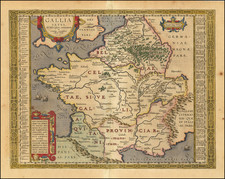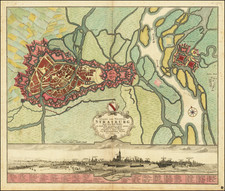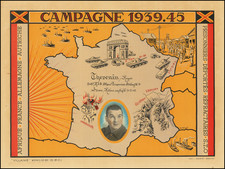Tabula Europae III, a 1561 map by Girolamo Ruscelli, presents an intriguing cartographic perspective of Western Europe, focusing primarily on France, while also extending its reach to the Low Countries and the western part of Germany. Stretching from the Atlantic to the Rhine River and along the Mediterranean coast, the map offers a rendition of the region based on Ptolemaic geographical understanding.
The geographic regions delineated in the map—Gallia Belgica, Germania Inferior, Germania Superior, Narbonensis, Aquitania, Lugdunensis—are rooted in the territorial organization of the Roman Empire. Gallia Belgica, once a province of the Roman Empire, corresponds to parts of present-day Belgium, the Netherlands, Luxembourg, and parts of Northern France and Western Germany. Germania Inferior and Germania Superior, meaning Lower and Upper Germany respectively, represented Roman provinces located mainly in modern Belgium and Germany. Narbonensis, primarily situated in the southern part of modern-day France, was named after its capital Narbo Martius (present-day Narbonne), a crucial commercial hub during the Roman period. Aquitania, roughly equivalent to the historical region of Aquitaine in southwestern France, extends from the Pyrenees to the river Loire. Lugdunensis, named after its capital Lugdunum (modern Lyon), was situated in the central part of what is now France.
Ruscelli's work belongs to the tradition of Renaissance cartography that sought to revise and improve upon classical knowledge in the light of new discoveries and a more advanced understanding of geography and projection techniques. His maps, therefore, offer a snapshot of the transition between ancient and modern cartography, making them of particular interest to scholars and collectors alike.
Girolamo Ruscelli (1500-1566) was a cartographer, humanist, and scholar from Tuscany. Ruscelli was a prominent writer and editor in his time, writing about a wide variety of topics including the works of Giovanni Boccaccio and Francesco Petrarch, Italian language, Italian poetry, medicine, alchemy, and militia. One of his most notable works was a translation of Ptolemy’s Geographia which was published posthumously.
There is limited information available about Ruscelli’s life. He was born in the Tuscan city of Viterbo to a family of modest means. He was educated at the University of Padua and moved between Rome and Naples until 1548, when he moved to Naples to work in a publishing house as a writer and proofreader. He remained in the city until his death in 1566.









![[Piedmont Region, Italy and Berry Region, France] Biturigum provinciae quae Berrij : Vulgo dicitur chorographica descriptio / Pedemontanae totius Italiae fertilissimae Regionis unca cum suis finitimus elegantissimo descripto](https://storage.googleapis.com/raremaps/img/small/75339.jpg)



![[ France ] Galliae Regionis Nova Descriptio](https://storage.googleapis.com/raremaps/img/small/81285.jpg)
![[France]](https://storage.googleapis.com/raremaps/img/small/77774.jpg)